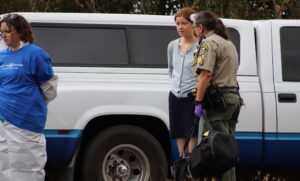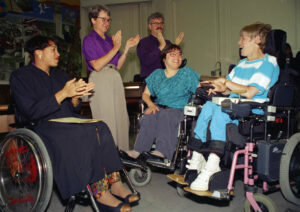Searching for Sustainable Models of Activism, 2 Years After Occupy
While economists are celebrating a tenuous recovery five years after the collapse of Lehman Brothers, this week’s US Census Bureau report on poverty provided a sobering statisticThis week’s U Census Bureau report on poverty provides a sobering statistic.
Editor’s note: Truthdig is pleased to announce a new weekly column by Sonali Kolhatkar, host of KPFK’s “Uprising.” Be sure to stay posted as this talented interviewer digs deeper into the important stories of the week.
While economists are celebrating a tenuous recovery five years after the collapse of Lehman Brothers, this week’s U.S. Census Bureau report on poverty provided a sobering statistic: 15 percent of Americans are poor, a number that has remained the same since last year. It seems recovery is for the rich; the well-being of poor Americans does not enter into the equation of how we measure national wealth.
Meanwhile, Lehman executives who were responsible for triggering the Great Recession are back at work, most of them in Wall Street firms, comfortably ensconced in the income brackets of the 1 percent.
Despite public outrage over the crimes of Wall Street executives, a Securities and Exchange Commission investigation was quietly swept under the rug and not a single Lehman employee was prosecuted. Huffington Post senior financial writer Ben Hallman told me in an interview that “we’ve seen again and again throughout the financial crisis that [government] authorities have been … extremely, overly cautious when it comes to bringing charges. … There’s been a real risk aversion among federal prosecutors to bring up these types of cases.”
After Lehman’s collapse, it took three years for people to get mad enough about the injustices of American capitalism and lack of government accountability to take to the streets. Two days after the fifth anniversary of Lehman Brothers’ collapse on Sept. 15 was the second anniversary of the start of the Occupy Wall Street movement.
The OWS movement spread rapidly in 2011 across the nation to cities large and small, and popularized the notion that we, Americans, are the 99 percent — the majority who are left out of the spoils of capitalism, and hit hardest by the unethical and greed-driven practices of Wall Street’s 1 percent.
Capturing the popular imagination, OWS encampments created activist innovations in communication and consensus building, feeding large numbers of people, setting up libraries and open mics, and even resolving disputes. The movement was chaotic and far from perfect but its power lay in symbolizing public outrage over the inequities of the financial system.
Sadly, only months later, the physical embodiments of that outrage — the tent cities — were dismantled by the state, sometimes roughly, and the slogan “We are the 99 percent” slipped slowly out of the mainstream consciousness.
Independent reporter Nathan Schneider was an eyewitness to OWS’ New York birthplace and he carefully documented the explosive presence of people power that burst into Zuccotti Park in his new book, “Thank You, Anarchy: Notes From the Occupy Apocalypse.” In it, Schneider explores OWS’ messy process of democratic engagement, writing perhaps the first history of the movement.
In focusing on the movement’s origins and evolution, he paid great attention to its many flaws — the provocateurs, the unwieldy nature of decision making, the debates over its goals. But, according to Schneider, “the things that were most exciting and most inspiring about what was going on were always juxtaposed against things that were frustrating and made you feel like it was about to collapse in on itself at any minute. And that tension was always there, and in some ways that was what put into stark relief the really beautiful moments, the moments that gave so many people hope.”
But, eventually, the movement dissolved. At worst, it ended; at best, it morphed into something less visible. Even if a good number of activists went on to start their own organizations or joined existing groups to work on issues such as foreclosure, debt and hurricane relief, the brash and powerful visibility of OWS that captured the mainstream imagination faded into the background.
Yet, Schneider asserted, OWS was a game changer. Explaining the subtitle of his book, “Notes From the Occupy Apocalypse,” he told me, “Apocalypse, in the Greek roots of the word means ‘unveiling.’ It refers to a moment in which something happens that’s so transformative that there’s no going back. The world has revealed itself as fundamentally different than we thought it was before.”
In looking toward the future of the movement, Schneider said, “Youthful energy can only carry you as long as a person can get by without sleeping. … The need for sustainable organization really became clear as the encampments were cleared.”
What sort of sustainable organizational methods can be used to address economic justice and build on OWS’ transformative moment? Of course, many venerable local organizations already exist and have done immense and important work, some even using the energy of OWS to make the points they had historically been making.
Longtime activist and author Sam Daley-Harris offered me his thoughts on sustainable and successful political action. Harris is the founder of the lobbying group RESULTS and has laid out his strategy for social justice in a book called “Reclaiming Our Democracy: Healing the Break Between People and Government,” now out in its 20th anniversary edition. His approach to progressive political action is slow, steady, results oriented and far more traditional than Occupy Wall Street.In explaining his own transformation, Harris told me how he got involved in the movement to address world hunger. In the beginning he thought, “Hunger was inevitable because there are no solutions. If there were solutions somebody would have done something by now … but I … realized there was no mystery to growing food, or clean water or basic literacy. I wasn’t hopeless about the lack of solutions; I was hopeless about human nature, that people would just never get around to doing what could be done. [But] there was one human nature I was in control of — my own.”
Harris, who has worked on global child mortality for more than 30 years, pointed out that the number of children’s deaths worldwide from vaccine-preventable diseases has dropped from 41,000 in 1984 to 18,000 today. “Year in and year out, decade in and decade out, RESULTS volunteers were working on that,” he said.
Under the model he devised, citizen volunteers join small groups of like-minded people, obtain training, education and communication skills on a specific problem and an equally specific solution to solve that problem. They break into public consciousness through traditional methods such as newspaper editorials and letters to the editor, and they directly pressure their elected officials — appealing to their sense of justice — to sponsor important legislation.
It’s certainly not as sexy as camping in a public place, holding general assemblies out in the open, marching and chanting slogans. And it does not work for the type of radical change OWS participants might have envisioned. But Harris’ approach offers a staid, yet relatively effective method of incremental reform that works within existing political systems.
There is merit in both approaches to activism — sometimes society needs the type of revolutionary spark embodied by Occupy Wall Street. And sometimes that spark needs to be followed by sustainable organizing that can foment change in baby steps through arduous work and even traditional channels.
Clearly OWS’ cause is still urgent: Wall Street is booming while wages are stagnant. Congress wants to cut food stamps even though poverty remains at a shocking 15 percent. And worst of all, the very same practices that led to the Great Recession are still legal, if barely.
But the piecemeal solutions are simple even if they won’t overturn capitalism: increasing the minimum wage, preserving and strengthening the food stamp program, prosecuting Lehman Brothers’ executives, passing regulations strong enough to curb recession-provoking practices.
As a warning of how well Wall Street has recovered five years after the crash and two years after Occupy Wall Street, the HuffPost’s Hallman dug into the current whereabouts of 63 Lehman executives and found that “most of them have not sought to hide their former Lehman association. … Remember those iconic images of the Lehman employees walking out with boxes and all their possessions that were beamed around the world right after they filed for bankruptcy? I was personally surprised to find that many of them had taken those boxes across the street.”
What’s to stop Lehman’s onetime employees from repeating their dubious deeds in other venues? “Not enough has been done. The possibility of another Lehman-type disaster is still a reality,” Hallman argued.
In today’s climate, even baby steps could make a world of difference. America’s wealthy elites have enjoyed so much privilege, they may think they are immune to popular discontent.
But if activists can combine the beautiful rage of Occupy Wall Street with some of the tried-and-tested methods of incremental political change, maybe someday justice will rain on Wall Street’s parade.
Your support matters…Independent journalism is under threat and overshadowed by heavily funded mainstream media.
You can help level the playing field. Become a member.
Your tax-deductible contribution keeps us digging beneath the headlines to give you thought-provoking, investigative reporting and analysis that unearths what's really happening- without compromise.
Give today to support our courageous, independent journalists.









You need to be a supporter to comment.
There are currently no responses to this article.
Be the first to respond.